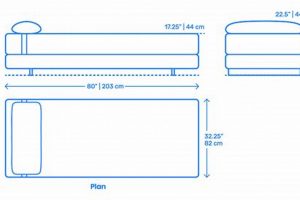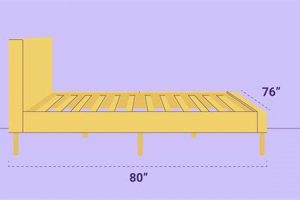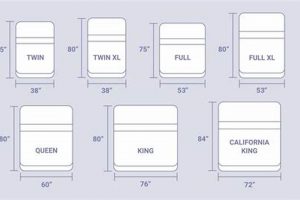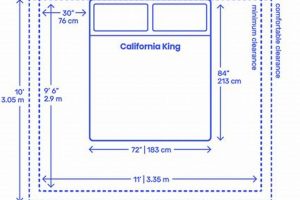A standard queen size mattress with an added layer of padding sewn onto the top for increased comfort is a common bedding choice. The overall measurements of this type of mattress are crucial for selecting appropriate bed frames, bedding, and ensuring compatibility with bedroom layouts. The width typically measures 60 inches, while the length extends to 80 inches. However, the addition of the extra padded layer on top alters the overall thickness.
Understanding these measurements is important for several reasons. Accurate dimensions allow for the selection of properly fitting sheets, blankets, and mattress protectors. Furthermore, knowledge of the mattress size ensures compatibility with bed frames, preventing overhang or insufficient support. Historically, this mattress style evolved to offer a more luxurious and comfortable sleep surface compared to traditional mattresses. The extra padding provides enhanced cushioning and pressure relief.
The subsequent sections will delve into the specific considerations for choosing bedding, selecting appropriate bed frames, and addressing common questions related to this specific mattress style. It is essential to assess bedroom space and individual preferences when determining suitability.
Considerations for Queen Pillow Top Mattress Selection
Careful consideration of several factors is essential when selecting a queen size mattress with a pillow top. The following tips provide guidance for making an informed decision.
Tip 1: Verify Room Dimensions: Before purchasing, measure the intended bedroom space. Ensure adequate room exists not only for the bed itself, but also for movement and surrounding furniture. Consider door swing and accessibility around the bed.
Tip 2: Assess Bed Frame Compatibility: The thickness of the pillow top can affect frame compatibility. Verify the frame’s weight capacity and ensure it adequately supports the mattress and its occupants. Some frames may require additional support due to the mattress height.
Tip 3: Investigate Pillow Top Construction: The materials used in the pillow top influence comfort and durability. Research foam density, fiber fill, and stitching quality. Higher quality materials tend to offer enhanced support and longevity.
Tip 4: Evaluate Edge Support: Pillow tops can sometimes compromise edge support. Test the mattress edges to ensure they provide adequate support when sitting or lying near the perimeter. Reinforced edges can extend the usable sleep surface.
Tip 5: Consider Sheet Depth: The added height of the pillow top requires deeper pocket sheets. Measure the mattress thickness accurately and select sheets with a pocket depth that exceeds this measurement to prevent slipping or tearing.
Tip 6: Examine Warranty Terms: Review the mattress warranty carefully, paying attention to coverage related to sagging, indentations, and defects in materials or workmanship. Understand the process for filing a claim and any associated costs.
Effective selection of a pillow top mattress involves careful evaluation of space, frame compatibility, construction quality, edge support, bedding needs, and warranty provisions. These considerations contribute to long-term satisfaction.
The next section will address common inquiries and provide further clarifications related to queen size pillow top mattress characteristics and maintenance.
1. Overall Width
The overall width of a queen pillow top mattress is a foundational specification that directly impacts its suitability for various bedroom sizes and frame designs. This dimension is crucial for space planning and affects both the comfort and functionality of the bed.
- Standard Measurement
The standard width is 60 inches. This fixed dimension is a key reference point for matching with appropriately sized bed frames, ensuring that the mattress fits without overhang or gaps. It also dictates the minimum bedroom width required to comfortably accommodate the bed and allow for movement around it.
- Impact on Bedding Selection
The 60-inch width is a primary factor when selecting bedding. Fitted sheets, flat sheets, and comforters are designed to correlate with this width, ensuring a proper fit and preventing discomfort or inconvenience. Deviations from this standard are rare and usually indicate custom-made mattresses, requiring specialized bedding.
- Spatial Planning Implications
Considering the 60-inch width is crucial in bedroom layout. It influences the placement of nightstands, dressers, and other furniture, ensuring adequate walkways and preventing a cramped feel. Smaller rooms may necessitate careful consideration to avoid overcrowding.
- Influence on Frame Stability
The bed frame must be designed to accommodate and properly support the mattress, particularly the 60-inch width. Frame designs that do not adequately account for this dimension may result in instability or premature wear of the mattress.
Therefore, attention to the overall width of a queen pillow top mattress is essential for proper integration into a bedroom setting. This dimension is directly linked to spatial planning, bedding selection, frame stability, and overall comfort, underscoring its significance in the selection process.
2. Overall Length
The overall length of a queen pillow top mattress is a critical dimension that influences both individual comfort and the practical layout of a bedroom. It directly impacts the ability of individuals to sleep comfortably and the efficiency of space utilization within the room.
- Standard Measurement and Accommodation
The standard overall length for a queen mattress is 80 inches. This dimension is designed to accommodate the average height of individuals, providing sufficient space for comfortable sleep. Failure to account for this length can result in discomfort and restricted movement during sleep.
- Bed Frame and Foundation Compatibility
The 80-inch length necessitates compatibility with bed frames and foundations specifically designed for queen mattresses. Incompatibility can lead to inadequate support, mattress damage, and a compromised sleep experience. Accurate measurement and matching of frame dimensions are therefore essential.
- Impact on Room Layout and Aesthetics
This dimension significantly affects the layout of a bedroom. In smaller spaces, the 80-inch length may dictate furniture placement and influence the overall aesthetics of the room. Careful planning is required to ensure that the mattress fits without impeding movement or creating a cramped environment.
- Consideration for Shared Sleeping Spaces
For couples or individuals who share the bed with pets, the overall length contributes to the sense of personal space. Adequate length ensures that both occupants have sufficient room to stretch and move without disturbing one another. This aspect is crucial for promoting uninterrupted sleep.
In summary, the overall length of a queen pillow top mattress is a fundamental dimension that must be carefully considered for optimal comfort, bed frame compatibility, spatial planning, and the overall sleeping experience. An accurate understanding of this dimension is vital for making informed purchasing decisions and creating a functional and comfortable bedroom environment.
3. Total Height
The total height, or thickness, of a queen pillow top mattress represents a crucial component within the overall “queen pillow top mattress dimensions”. This measurement is the cumulative vertical distance from the mattress’s base to the highest point of the pillow top layer. It is influenced by the core mattress construction, materials used, and the specific design and thickness of the integrated pillow top. Variations in the total height can affect bed frame compatibility, ease of getting in and out of bed, and the selection of appropriate bedding. For example, a mattress with a significant pillow top may require deeper-pocketed sheets to ensure a secure and proper fit. The total height also impacts the aesthetics of the bed, influencing its visual prominence within the room and its proportional relationship with other furniture.
An increased total height, often resulting from a thicker pillow top, may enhance comfort by providing additional cushioning and support. However, it can also present practical challenges. A taller mattress may make it more difficult for individuals with mobility issues to get onto and off of the bed. Furthermore, certain bed frames, particularly those with headboards or footboards, may not be suitable for mattresses with excessive height, potentially obscuring design elements or compromising structural integrity. Understanding the relationship between total height and the overall “queen pillow top mattress dimensions” is therefore essential for ensuring a comfortable and functional sleeping environment. It also enables informed decision-making when selecting bed frames and bedding accessories, promoting both comfort and aesthetic harmony.
In summary, the total height of a queen pillow top mattress is an integral dimension impacting aesthetics, accessibility, and the selection of compatible accessories. While contributing to potential comfort enhancements, this measurement requires careful consideration of practical implications, including bed frame compatibility and accessibility challenges. Accurately assessing total height and its role within “queen pillow top mattress dimensions” allows for a balanced approach to mattress selection, optimizing both sleep quality and room functionality.
4. Pillow Top Thickness
The pillow top thickness of a queen size mattress directly influences its overall dimensions and, consequently, its suitability for specific bed frames, bedding, and individual needs. This measurement refers to the additional layer of padding affixed to the uppermost surface of the mattress, contributing to enhanced comfort but also affecting the total height and required sheet depth.
- Impact on Overall Mattress Height
The thickness of the pillow top directly contributes to the overall height of the mattress. A thicker pillow top increases the mattress’s profile, potentially affecting the ease of getting in and out of bed. This dimension must be considered when assessing bed frame compatibility and ensuring the resulting bed height is appropriate for the user’s needs and preferences.
- Sheet Depth Requirements
Pillow top thickness significantly impacts the required depth of fitted sheets. Standard sheets may not adequately cover a mattress with a particularly thick pillow top, leading to slippage and discomfort. Careful measurement of the mattress height, including the pillow top, is necessary to select sheets with sufficient pocket depth.
- Influence on Bed Frame Selection
Certain bed frames may be incompatible with mattresses possessing a substantial pillow top. Frames with headboards or footboards may not accommodate the increased height, potentially obscuring design elements or compromising structural integrity. Low-profile frames may be necessary to maintain a comfortable bed height when combined with a thick pillow top.
- Considerations for Edge Support
A thicker pillow top can sometimes compromise edge support. Individuals who frequently sit on the edge of the bed or utilize the entire sleep surface may experience less stability compared to mattresses with reinforced edges or thinner pillow tops. This trade-off between comfort and edge support should be evaluated based on individual needs and preferences.
In conclusion, pillow top thickness is an integral component of overall dimensions that influences bed frame compatibility, sheet selection, accessibility, and support characteristics. A thorough understanding of this dimension ensures a well-informed purchasing decision that aligns with individual needs and preferences, optimizing both comfort and functionality within the bedroom environment.
5. Frame Overhang
Frame overhang, in the context of “queen pillow top mattress dimensions,” refers to the extent to which a mattress extends beyond the supporting bed frame. This phenomenon has practical and aesthetic implications, influencing both the mattress’s stability and the overall appearance of the bed within a room. Proper alignment between frame and mattress dimensions is essential for optimal performance and visual harmony.
- Dimensional Discrepancies
Variations in “queen pillow top mattress dimensions,” particularly in width and length, can lead to frame overhang. If the mattress exceeds the frame’s dimensions, the overhanging portion lacks support, potentially causing sagging and accelerated wear. Conversely, an undersized mattress results in gaps, compromising stability and presenting a safety hazard. Precise measurement and matching of dimensions are therefore critical to prevent these issues.
- Impact on Mattress Support
Frame overhang directly affects the level of support provided to the mattress. The portion extending beyond the frame lacks the necessary foundation, leading to uneven weight distribution and potential damage to the mattress’s structure. This is particularly relevant for pillow top mattresses, where the added padding can exacerbate the effects of inadequate support. Prolonged overhang can result in premature sagging and reduced comfort.
- Aesthetic Considerations
The presence of frame overhang can detract from the overall aesthetic appeal of a bed. An ill-fitting mattress disrupts the clean lines and visual balance, creating an unkempt or mismatched appearance. Attention to the “queen pillow top mattress dimensions” and their relationship to the frame is necessary to achieve a cohesive and visually pleasing bedroom design. The frame should ideally provide a flush or slightly recessed fit for the mattress.
- Safety Implications
Excessive frame overhang can pose a safety risk. The unsupported edges of the mattress may become unstable, potentially leading to accidental falls or injuries. This is particularly relevant for individuals with mobility issues or for children who may climb on the bed. A secure and properly supported mattress is essential for maintaining a safe sleeping environment.
In summary, frame overhang is a significant consideration when evaluating “queen pillow top mattress dimensions”. Dimensional accuracy is critical to ensure adequate support, maintain aesthetic integrity, and promote a safe sleeping environment. Proper alignment between the mattress and the frame is essential for maximizing the longevity and performance of the bedding system.
6. Sheet Depth
Sheet depth is a critical parameter directly related to “queen pillow top mattress dimensions”, specifically the mattress’s overall thickness. It determines the compatibility of fitted sheets with the mattress, ensuring a secure and comfortable fit. Inadequate sheet depth leads to slippage and an unsatisfactory sleep experience, while proper sheet depth contributes to both comfort and aesthetic appeal.
- Measurement and Accommodation of Thickness
Sheet depth refers to the vertical distance from the sheet’s corner seam to its elasticized edge. This measurement must exceed the mattress’s total height, including any pillow top, to ensure a secure fit. Queen pillow top mattresses, due to their added layer of padding, often require deeper-pocket sheets than standard mattresses. For instance, a mattress measuring 14 inches in thickness necessitates sheets with a pocket depth of at least 15 inches to allow for tucking and prevent slippage. Failure to accommodate this dimension results in the fitted sheet constantly pulling off the corners of the mattress.
- Material and Elasticity Considerations
The material composition and elasticity of fitted sheets influence their ability to accommodate variations in mattress thickness. Sheets made from flexible and resilient fabrics, such as cotton blends with elastane, tend to adapt better to different mattress heights. In contrast, rigid or non-stretch materials may struggle to conform to the contours of a thick pillow top, increasing the likelihood of slippage or tearing. The elasticity of the sheet’s edge also plays a role, as a stronger elastic band provides a more secure grip on the mattress.
- Impact on Comfort and Sleep Quality
Inadequate sheet depth compromises comfort and sleep quality. A fitted sheet that constantly pulls off the corners creates wrinkles and discomfort, disrupting sleep. A properly fitting sheet, on the other hand, provides a smooth and secure surface, promoting a more restful and uninterrupted sleep experience. Furthermore, a well-fitted sheet contributes to a more aesthetically pleasing bed, enhancing the overall ambiance of the bedroom.
- Labeling and Consumer Awareness
Consumer awareness regarding sheet depth is essential for making informed purchasing decisions. Manufacturers typically indicate the pocket depth on sheet packaging. However, variations in labeling standards and measurement techniques can lead to discrepancies. Consumers should carefully measure their mattress’s thickness and compare it to the sheet’s stated pocket depth, allowing for slight variations due to fabric shrinkage or manufacturing tolerances. Consulting product reviews and seeking recommendations from other consumers can provide valuable insights into the accuracy and reliability of sheet depth labeling.
Sheet depth is inextricably linked to “queen pillow top mattress dimensions”, directly affecting the fit, comfort, and overall sleep experience. Neglecting this dimension leads to practical inconveniences and compromised sleep quality, while careful consideration ensures a secure, comfortable, and aesthetically pleasing bedding arrangement. Understanding the interplay between sheet depth, mattress thickness, and material properties is crucial for informed consumer decision-making.
Frequently Asked Questions
The following addresses common inquiries regarding the measurements and related considerations for queen size mattresses with a pillow top. These responses aim to provide clarity on essential aspects relevant to purchasing decisions and practical applications.
Question 1: What are the standard overall dimensions of a queen pillow top mattress?
The standard width is 60 inches, the standard length is 80 inches. The height varies depending on the pillow top’s thickness, but typically ranges from 12 to 16 inches.
Question 2: How does the pillow top affect the required sheet depth?
The addition of a pillow top increases the overall mattress height, necessitating deeper-pocket sheets. It is essential to measure the mattress’s total height, including the pillow top, and select sheets with a pocket depth that exceeds this measurement by at least one inch.
Question 3: Does the presence of a pillow top impact the type of bed frame that can be used?
Yes. The height of the mattress, increased by the pillow top, can affect compatibility with certain frames, particularly those with headboards or footboards. A lower profile frame may be necessary to avoid obscuring the headboard or creating an excessively high bed.
Question 4: How does the pillow top influence the weight of the queen mattress?
The added materials of the pillow top increase the overall weight. This is relevant when considering frame weight capacity and ease of moving the mattress.
Question 5: Can pillow tops affect the lifespan or warranty of a queen mattress?
The quality of materials used in the pillow top construction influence its longevity. Check warranty terms for coverage related to pillow top sagging or compression.
Question 6: Do specific mattress brands adhere to strict standard dimensions?
While general standards exist, slight dimensional variations can occur between manufacturers. Always confirm the exact measurements of a specific mattress prior to purchase, especially if frame fit is a critical concern.
These FAQs highlight the importance of understanding the precise measurements of queen pillow top mattresses for selecting appropriate bedding, frames, and ensuring long-term satisfaction.
The next section will offer guidance on maintaining this style of mattress.
Concluding Summary
This article has rigorously examined the critical dimensions of a queen pillow top mattress, emphasizing the interplay between width, length, total height, pillow top thickness, frame overhang, and sheet depth. Understanding these measurements is essential for selecting compatible bed frames, ensuring proper bedding fit, and optimizing comfort. Neglecting these dimensional considerations can lead to compromised support, aesthetic inconsistencies, and a reduction in sleep quality. Precise measurements and a thorough understanding of how each dimension contributes to the overall bedding system are paramount.
Therefore, a prospective purchaser must meticulously evaluate these dimensional factors before acquisition. The longevity and performance of a bedding system depend on the proper matching of mattress and frame, and the appropriate selection of sheets. This diligence ensures that the sleep environment promotes rest and provides durable support.






![King vs California King: Mattress Dimensions Guide [2024] Organic & Natural Mattress Buyer’s Guide: Non-Toxic Sleep Solutions King vs California King: Mattress Dimensions Guide [2024] | Organic & Natural Mattress Buyer’s Guide: Non-Toxic Sleep Solutions](https://mattressworldpa.com/wp-content/uploads/2025/07/th-644-300x200.jpg)
